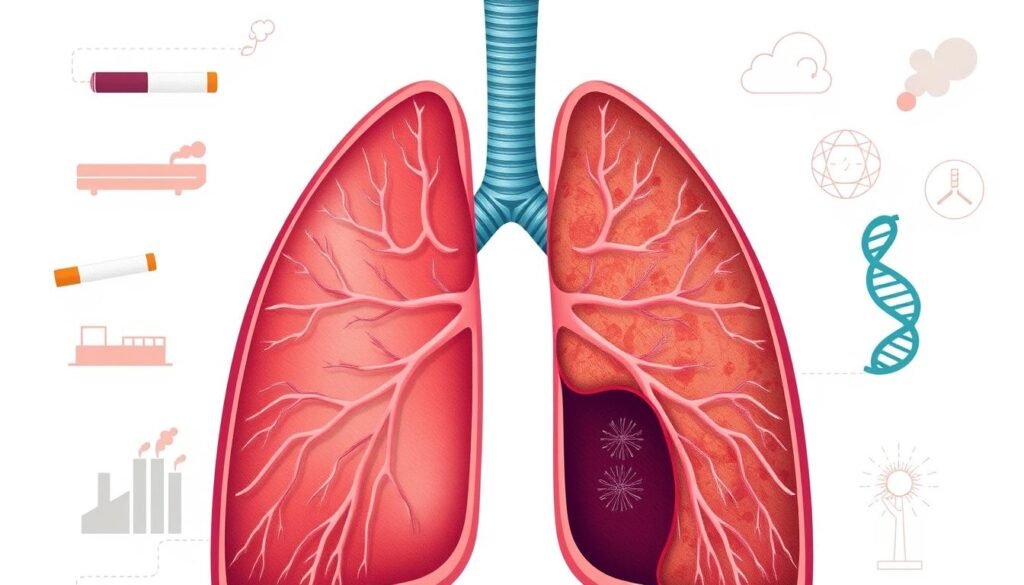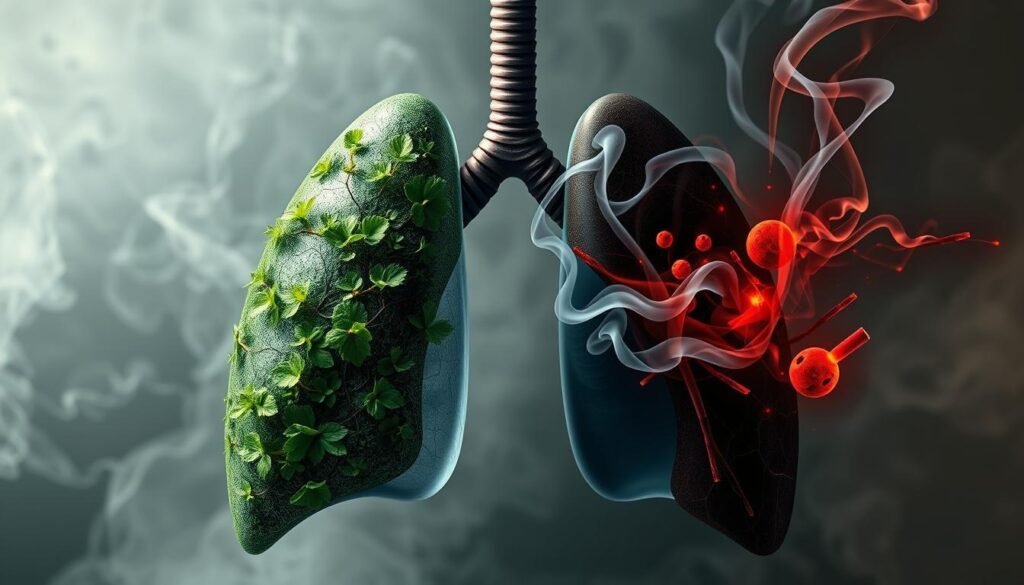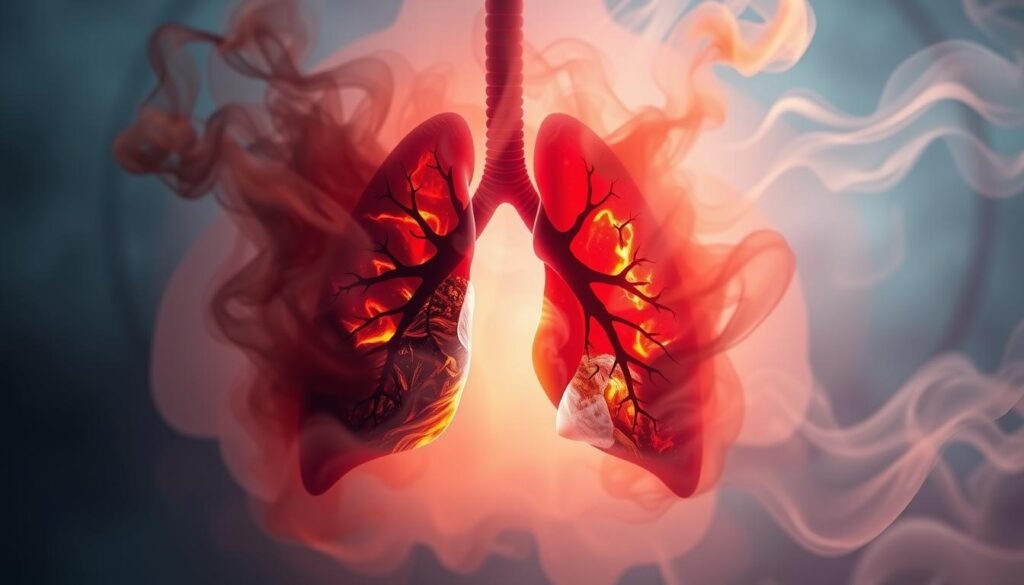Did you know smoking causes about 85 percent of lung cancer cases? This big number highlights the impact that stopping smoking can have. Quitting can greatly decrease the chance of getting this serious disease. It’s never late to stop. Research from the New England Journal of Medicine finds quitting before 40 reduces death risk by up to 90 percent. Knowing the risk of lung cancer after quitting smoking is vital. This article will talk about how stopping smoking affects lung cancer risk. And what factors matter in this important decision.
Key Takeaways
- Smoking is responsible for 85% of lung cancer cases.
- Quitting before age 40 can lower premature death risk by 90%.
- Smoking cessation significantly impacts lung cancer risk reduction.
- Annual screenings are vital for former smokers, particularly heavy smokers.
- Understanding risks associated with smoking aids in effective cancer prevention.
The Importance of Quitting Smoking
Quitting smoking is key to a healthier, longer life. Studies show that stopping smoking can add 10 years to your life. For those who quit by 40, the risk of dying from smoking-related diseases drops by 90%.
Tobacco Addiction is harmful to your body and mind. Quitting reduces the risk of many cancers, like stomach and liver cancer. It also cuts down on diseases like COPD and heart issues. You’ll start seeing benefits right after you quit.
Just minutes after quitting, your heart rate gets better. In 24 hours, your body clears out all nicotine. After a month, breathing improves a lot, reducing coughing and breathlessness. This leads to a lower risk of heart disease in 1 to 2 years and less cancer risk over time.
Quitting smoking involves help from groups like the American Cancer Society and CDC. They offer resources to help you live healthier and fight Tobacco Addiction. Stopping smoking improves your health and life, lowers healthcare costs, and boosts social life.
| Time After Quitting | Health Improvements |
|---|---|
| Minutes | Heart rate drops to a normal level |
| 24 Hours | Nicotine levels drop to zero |
| Several Days | Carbon monoxide levels reduce to that of a non-smoker |
| 1-12 Months | Coughing and shortness of breath decrease |
| 1-2 Years | Risk of heart attack drops significantly |
| 5-10 Years | Risk of cancers of the mouth, throat, and voice box cut in half |
Quitting smoking leads to long-lasting health benefits. It helps you live a life without addiction and greatly boosts your lung health.
Understanding Lung Cancer and Its Causes
Lung cancer is the top cause of cancer deaths globally, affecting millions each year. A big part of these cases is due to carcinogen exposure, especially from tobacco smoke. This consists of over 7,000 chemicals, with many known to cause cancer. They harm lung tissue, leading to cancer. Usually, heavy smokers develop small cell lung cancer. Other types include squamous cell carcinoma, adenocarcinoma, and large cell carcinoma, known as non-small cell lung cancer.

It’s key to understand lung cancer’s various causes for prevention. Besides smoking, other risks can increase lung cancer chances. Secondhand smoke is dangerous, especially for non-smokers. Other factors include past radiation therapy, radon gas, and asbestos exposure. Those with a smoking history face more risk with asbestos. A family history of lung cancer increases risks as well. Recognizing these risks is crucial for prevention.
Healthy living is essential for preventing lung cancer. One must avoid all tobacco products, including e-cigarettes. Adding fruits and veggies to your diet and exercising regularly boosts overall health. Such actions can lower carcinogen exposure risks. Being informed helps people make better choices. It highlights the importance of lung cancer screening and early detection.
People with a high risk should get yearly lung cancer checks using low-dose CT scans. This is vital for those with long smoking histories. Here’s a link with screening guidelines to help catch cancer early and improve survival chances. Knowing about lung cancer and its causes is crucial for lessening its effects.
How Smoking Increases Lung Cancer Risk
Smoking greatly increases lung cancer risk by exposing users to harmful chemicals. These include cancer-causing substances that damage DNA. They cause genetic changes and uncontrolled cell growth. In the U.S., 80% to 90% of lung cancer deaths are due to smoking. This shows the strong connection between smoking and lung cancer.
Here’s a scary fact: smokers are up to 30 times more likely to get or die from lung cancer. Even those who smoke a little are at higher risk. Mixing smoking with other carcinogens, like radon, makes it even worse. Thus, smokers are much more likely to develop lung cancer.
But there’s hope. Quitting smoking significantly reduces your cancer risk. Lung cancer risk falls by 42% for those who stop smoking. The biggest drop happens soon after quitting. If you quit before 50, your lung cancer risk goes down by 57%. This shows how vital it is to stop smoking early.
Quitting smoking not only helps with lung cancer. It reduces the risk for several other types. See this table for how much the risk falls for different cancers:
| Cancer Type | Risk Reduction After Quitting |
|---|---|
| Lung Cancer | 42% |
| Liver Cancer | 27% |
| Stomach Cancer | 14% |
| Colorectal Cancer | 20% |
Quitting after 50 still cuts your risk by 39%, compared to those who keep smoking. The sooner you quit, the better. Over time, quitting smoking continues to benefit your health. It shows the lasting advantages of giving up smoking.

Lung Cancer Risk After Stopping Smoking
Learning about the Lung Cancer Risk After Stopping Smoking is key for those thinking about quitting. Studies show that the chance of getting lung cancer goes down over time after you stop smoking. You can see a major drop in risk just months after you quit, and it keeps going down for years.
Timeframe for Risk Reduction
Studies show big decreases in risk for people who quit smoking:
- One year later, their risk of lung cancer is 81.4% of what it was.
- After 5 years, their risk drops to 57.2%.
- Ten years after quitting, the risk lowers further to 36.9%.
- After 15 years smoke-free, the risk is at 26.7%; it falls to 19.7% after 20 years.
This proves quitting smoking has a big impact on lowering Long-Term Health Risks.
Factors Influencing Individual Risk
Certain things can change a person’s risk of lung cancer after they quit:
- How old you are when you quit makes a difference.
- How much and how long you smoked matter too.
- Being around other risks, like certain jobs or if your family has a history of lung cancer, also affects your risk.
Even those who smoked a lot before may still face a higher risk for a while. But their risk slowly goes down to lower levels. It’s important for them to keep up with screenings and doctor visits. Learn more about lung cancer screening here.

Health Benefits of Quitting Smoking
Quitting smoking has big health benefits for you and the people around you. The moment you decide to stop smoking, you start a healthier life journey. Right away, your body begins to heal, bringing lots of short-term gains.
Immediate Benefits Post-Cessation
When you quit, you might notice:
- Improved taste and smell
- Better respiratory function
- Reduction in cough and bronchitis
Quitting smoking improves your daily life and sets you up for more benefits later on.
Long-Term Health Improvements
The long-term perks of stopping smoking are huge. Quitting smoking cuts your lung cancer risk. One study of over 500 people showed quitters lived about 22 months longer than smokers after an early-stage lung cancer diagnosis.
This fact stresses how important it is to stop smoking for cancer survival. About 75% of quitters were alive three years after their diagnosis, more than the 66% of smokers.
Stopping smoking not only adds years to your life. It also boosts how well you live. Early quitters had 5.7 years without their disease getting worse. That’s longer than the 3.9 years smokers had. Stopping smoking is key for a better, healthier life, especially after a lung cancer diagnosis.
| Age Group | Risk Reduction of Dying from Cancer |
|---|---|
| 15 to 34 | 100% |
| 35 to 44 | 89-90% |
| 45 to 54 | 78% |
| 55 to 64 | 56% |
Choosing to quit smoking is crucial for a healthy life. It can change how long and how well you live for the better.
Impact of Secondhand Smoke on Lung Cancer Risk
Secondhand smoke is a big health problem, especially for lung cancer. People around this smoke are more likely to get lung cancer. The risk can go up by 20%-30%. Studies have shown scary links between secondhand smoke and getting lung cancer early. For instance, being around smoke at work or during free time increases lung cancer risk before turning 25.
Secondhand smoke affects everyone, no matter who they are. For those who never smoked, being exposed from birth to age 25 makes lung cancer more likely. However, the risk is lower if the exposure starts after age 25. Even people who smoked before or still smoke face a high risk with early exposure. This shows how secondhand smoke harms both smokers and non-smokers.
Every year, over 7,300 adults who never smoked die from lung cancer because of secondhand smoke. These numbers show why we need places without smoke to prevent cancer. Also, secondhand smoke causes nearly 34,000 early deaths from heart disease among non-smokers each year. Kids and expectant mothers face more dangers, like sudden infant death syndrome, breathing problems, and being born too small.
To better understand the link between secondhand smoke and lung cancer risk, here’s a table:
| Exposure Stage | Adjusted Odds Ratio (AOR) | Population |
|---|---|---|
| Birth to age 25 | 1.30 | All participants with SHS exposure |
| After age 25 | 0.66 | All participants with SHS exposure |
| Birth to age 25 | 1.29 | Nonsmokers |
| After age 25 | 0.87 | Nonsmokers |
| Birth to age 25 | 1.28 | Current and ex-smokers |
| After age 25 | 0.66 | Current and ex-smokers |
Smoking Cessation and Cancer Prevention
Quitting smoking is key for cancer prevention. Those wanting to stop smoking gain much from support resources. Support like Quit Smoking counseling, programs, and cessation aids increases success chances.
Support Resources for Quitting Smoking
Many resources help people quit smoking. They include:
- Behavioral counseling for addiction’s psychological aspects.
- Nicotine replacement therapies (patches, gums) and medication.
- Peer support groups for community and sharing experiences.
Effective Quit Smoking Support boosts motivation and gives needed tools. Using these resources greatly helps in staying smoke-free.
Healthy Lifestyle Changes to Reduce Cancer Risk
Making healthy lifestyle changes also lowers cancer risks. Important steps include:
- Regular physical activity for heart health.
- A balanced diet with fruits, vegetables, and whole grains.
- Keeping a healthy weight to reduce cancer risk.
Lifestyle changes, along with stopping smoking, greatly benefit health over time. Quitting smoking gradually reduces lung cancer risk. It highlights the need for a full approach to cancer prevention.
It’s vital to keep aware of health risks. Lung cancer screenings are advised for those 50 to 80 who fit certain criteria. But, few get these important checks, showing more education on prevention is needed. Regular health check-ups are crucial, especially after quitting smoking.
Long-Term Health Risks After Quitting
Quitting smoking is great, but it still leaves long-term health risks. These risks, especially lung cancer, need attention. Former smokers should keep an eye on their health.
It’s important to have regular screenings and check-ups. This helps find problems early and may lead to better health outcomes.
Monitoring Your Health
Keeping a close watch on health is key for those who’ve quit smoking. Though the risk of lung cancer goes down after quitting, it’s still higher than for those who never smoked. If you’ve smoked a lot in the past, talk to your doctor about screening tests.
Regular Screenings and Check-ups
The American Cancer Society suggests yearly lung cancer screenings for heavy smokers and recent quitters. Getting screened regularly helps find health problems early.
Regular check-ups and screenings offer several benefits:
| Benefit | Description |
|---|---|
| Early Detection | Increases the chances of successful treatment and survival. |
| Risk Assessment | Helps gauge lung cancer risk based on personal smoking history. |
| Health Monitoring | Tracks ongoing health concerns related to past smoking. |
| Access to Resources | Healthcare professionals can provide necessary support and resources for maintaining health. |
Staying proactive with health check-ups and knowing about screening guidelines is crucial. This helps manage risks from previous smoking habits.
Conclusion
Quitting smoking is a big step toward lowering lung cancer risk. Even though former smokers have a higher risk than non-smokers, stopping smoking has huge health benefits. For example, five years after quitting, the risk of lung cancer for people who smoked a lot drops by 39 percent.
This decrease in risk shows it’s never too late to choose a healthier life to help prevent cancer. Quitting smoking is always a good idea for your health.
But, it’s key to know that even after not smoking for 25 years, the lung cancer risk is still over three times higher than for those who never smoked. This fact needs to shape public health plans and your own health choices. It means regular check-ups and early screenings for ex-smokers are really important.
We need to keep telling people about the risks of past smoking. This helps motivate them to care for their health.
So, while quitting smoking does mean you need to keep an eye on your health, it starts you on the road to a healthier life. Helping ex-smokers with resources and knowledge can help them make smart choices. This also helps the community by raising awareness and efforts to prevent lung cancer.